Choir stalls Saint-Jean-Baptiste at Montrésor - France
Life, Faith, and Imagination in Oak
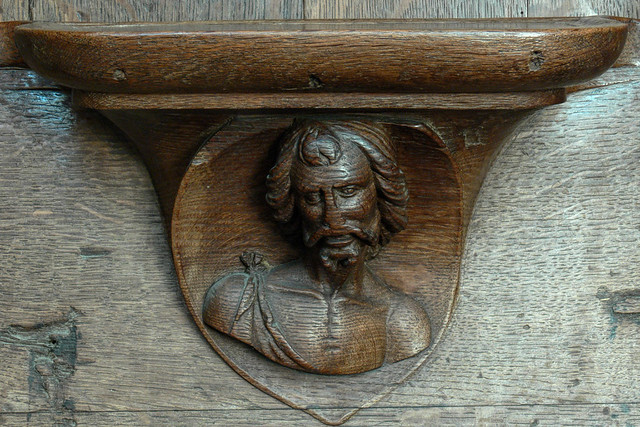
The choir stalls of the collegiate church of Saint-Jean-Baptiste at Montrésor form one of the most eloquent ensembles of Renaissance woodcarving in Touraine. They were made around 1530-1540, when Imbert de Batarnay, seigneur of Montrésor and counsellor to four French kings, endowed the new collegiate foundation he had created in 1521. Twenty-one canons were to occupy these seats, and their stalls still line both sides of the choir in sober oak, their surfaces alive with carving that combines gravity, wit and learned ornament.
Each seat bears beneath its hinged seat a small console, the misericorde, and on the ends rise projecting bench-ends capped with a sculpted bust, creature or scroll. The decoration belongs wholly to the idiom of the early French Renaissance: the Gothic tracery has vanished, replaced by volutes, acanthus leaves, and medallions derived from antique cameos. The modelling is confident and tactile, the humour restrained yet humane. Though the sculptor’s name is lost, the work is typical of workshops active around Tours and Loches in the reign of Francis I, where the new Italianate taste mingled with local craftsmanship.
The Misericords
The misericords of the collegiate church of Saint-Jean-Baptiste at Montrésor form the most intimate and contemplative part of its 16th-century choir stalls. Carved in oak around 1530–1540, they were conceived both as practical supports for the clergy during long offices and as vehicles for reflection on spiritual themes. Their small scale invited invention, and within their confined space the carver explored a range of imagery that unites Gothic vitality with Renaissance humanism.
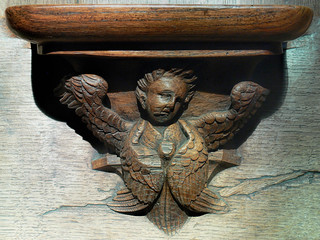
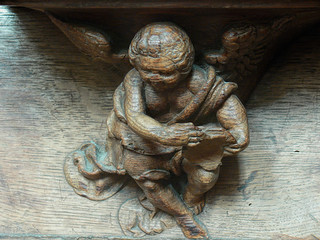
One depicts a seraph whose head and layered wings form a living bracket beneath the seat; the design fuses structural purpose with theological symbolism, its flowing feathers rendered in rhythmic precision. A winged child or putto intent upon writing upon a scroll, introduces the Renaissance ideal of divine inspiration and learning, recalling the recording angels of Italian art.
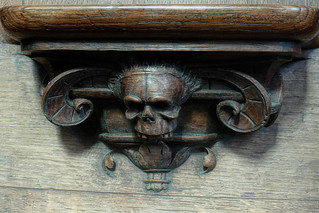

Another contrasts sharply with this vision of celestial purity: a skull framed by scrolls and mouldings, a stark yet beautifully modelled memento mori reminding the canons of life’s transience. A final carving, a cherub’s head enfolded in heart-shaped wings, restores the theme of redemption through gentle, compassionate expression.
Together, these carvings form a meditation on mortality and salvation: innocence, death, and renewal in turn. Their style, balancing the linear grace of late Gothic carving with the calm order of the early French Renaissance, embodies the refined craftsmanship of the Loire workshops under Francis I. Each piece, mellowed by the patina of centuries, preserves the spirit of devotion for which it was conceived.
The Bench Ends
The vertical panels or bench ends of the Montrésor stalls are adorned with a series of carved medallions, each containing a bust presented in profile within a circular frame. These portraits, inspired by antique coins and medals, transform the sacred furniture into a humanist portrait gallery. Their craftsmanship suggests the work of an artist familiar with contemporary French courtly style, combining classical restraint with lively individuality.
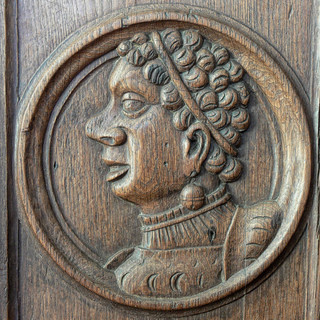
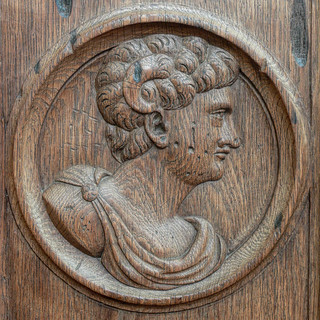
One head portrays a man with curling hair and a jaunty cap, his prominent features rendered with humour and vitality; he may stand for Courage or the spirited worldliness of the Renaissance courtier. Another, smoother and more idealised, shows a youthful male with short curls and a draped garment, an echo of antique virtue or contemplative Reason.
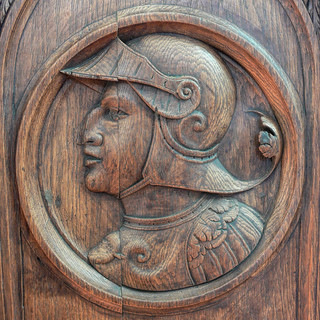

The warrior in a plumed helmet that follows is noble and self-contained, his armour delicately incised; he may represent the Miles Christianus, the Christian knight defending the faith. The final bust, a man with a beard and beret, evokes the scholar or poet, symbol of learning and reflection.
These medallions, though not portraits of individuals, project an ideal of human dignity shaped by Renaissance humanism. They stand as moral exemplars as much as decoration, their calm profiles contrasting with the expressive fantasy of the misericords below.
The Jouées or Stall Ends
The jouées, or outer stall ends, are conceived as sculptural terminals, uniting the structure’s architecture with a rich bestiary of carved figures. Each piece transforms a functional support into a lively study of form and meaning, blending the playfulness of late medieval carving with the elegance of Renaissance design.

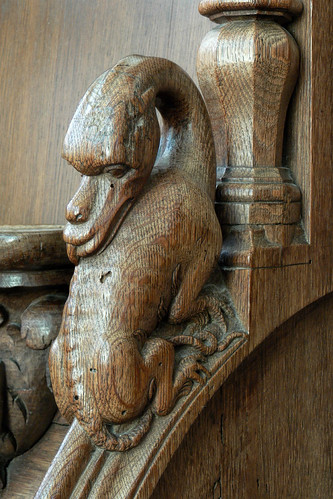
Among these are several fantastic creatures: one a bird-beast whose long neck curves back upon itself, perhaps recalling the pelican or phoenix—symbols of sacrifice and resurrection. Another takes the form of a crouching monster, a hybrid of reptile and mammal whose coiled pose seems to restrain its latent energy, a reminder of passions subdued by faith.
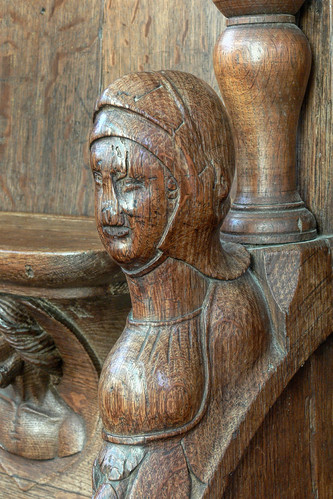
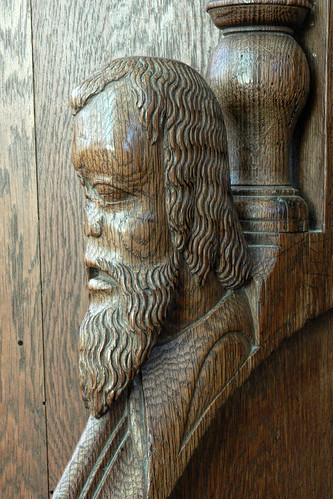
While nearby a female bust in a close-fitting hood lends a calm human counterpoint to the surrounding beasts. A male head with flowing beard introduces another note of introspection, his downward gaze suggesting meditation or wisdom.
These figures reveal the carver’s delight in variety: the contrast between grotesque and serene, animal and human, spiritual and earthly. They bind the entire ensemble together, each element flowing naturally into the next, transforming the choir into a unified work of sculpture.
Taken as a whole, the stalls of Montrésor embody the spirit of the French Renaissance at its most introspective and humane. The misericords explore the mysteries of life, death, and redemption; the bench ends celebrate the dignity of man through idealised portraiture; and the jouées express the vitality of creation in all its forms. Together they unite moral reflection, devotional purpose, and aesthetic refinement, an enduring testament in oak to the artistic flowering of the Loire Valley in the early sixteenth century.
